INTERNACIONAL
Butler one year later: Revisiting the historic assassination attempt against Donald Trump
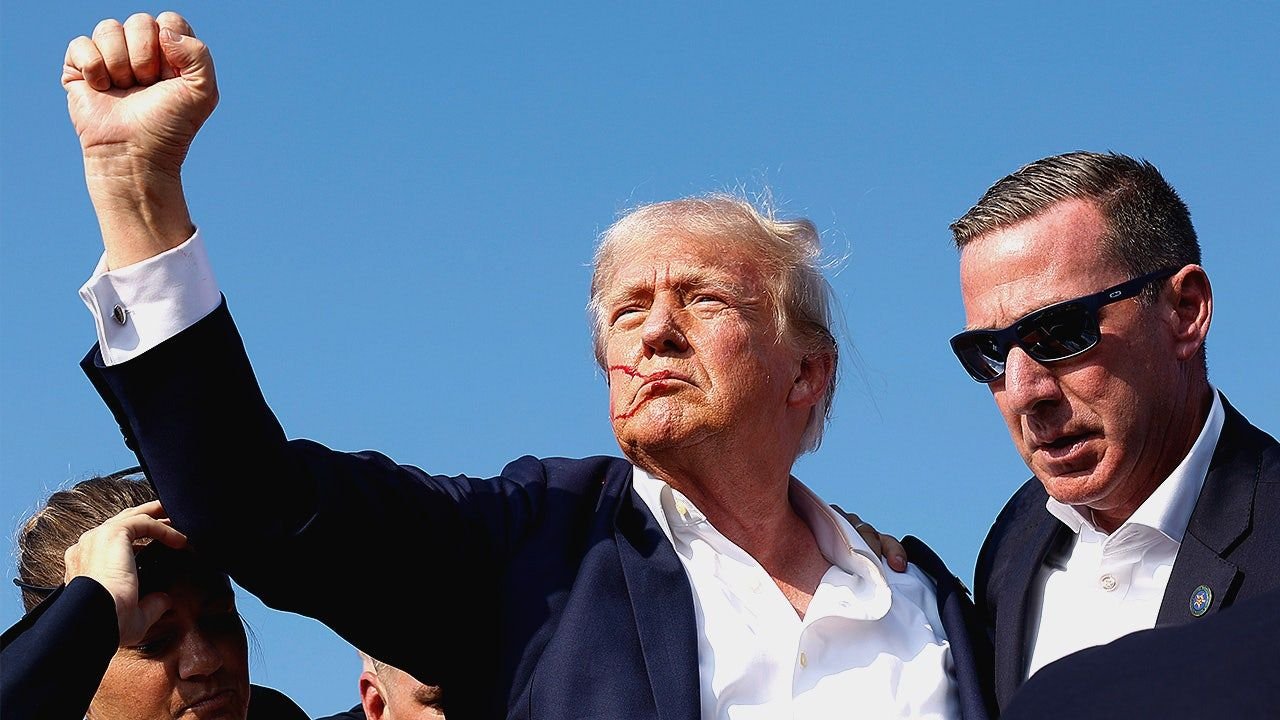
NEWYou can now listen to Fox News articles!
Presidential candidate Donald Trump took the stage at a routine campaign rally in Butler, Pennsylvania, exactly a year ago, on July 13, 2024, one of hundreds he’d appeared at since announcing his first presidential campaign in 2015.
But this rally turned out unlike any other of his political career.
As Trump stood at the podium, with supporters holding signs that said «Joe Biden, you’re fired!» directly behind him, the president pointed to a chart detailing low illegal immigration numbers at the end of his first term and how they’d risen under the Biden administration.
«That chart’s a couple of months old, and if you want to really see something that’s sad, take a look at what happened,» Trump said, halting as the sound of gunshots pierced the air.
Republican presidential candidate Donald Trump reacts as multiple shots rang out during a campaign rally at the Butler Farm Show in Butler, Pennsylvania, July 13, 2024. (Brendan McDermid/Reuters)
TRUMP REVEALS CRUCIAL, SPLIT-SECOND MOMENT THAT SAVED HIS LIFE DURING BUTLER ASSASSINATION ATTEMPT
Moments later, Trump ducked, and Secret Service agents rushed to his side. More gunshots followed, and attendees fearfully screamed while Trump remained covered, waiting for the all-clear sign.
Once given the green light, Secret Service personnel rose alongside Trump to escort him from the stage. But Trump didn’t hide himself from his supporters. Instead, he emerged from the huddle, raised his fist high in the air, and said «fight» three times, prompting the audience to erupt and chant «U-S-A!» as he exited.
Ultimately, 20-year-old gunman Thomas Matthew Crooks fired eight bullets at Trump from a rooftop during the rally, with a bullet grazing Trump’s ear. The gunman also killed Corey Comperatore, a 50-year-old firefighter, father and husband attending the rally, and injured two others.
A Secret Service sniper killed Crooks during the shooting, and an FBI investigation remains in progress. No motive has been determined for why Crooks conducted the attack.
Classmates of Crooks have described him as a «loner» subjected to bullying, and the FBI told reporters in August 2024 that Crooks likely suffered from an undiagnosed disorder.
FIRST RESPONDERS SIT DOWN WITH WIDOW OF FIREFIGHTER KILLED AT BUTLER, PENNSYLVANIA, TRUMP RALLY

The Secret Service tends to Donald Trump onstage at a rally July 13, 2024, in Butler, Pennsylvania. (Anna Moneymaker/Getty Images)
«It was unforgettable,» Trump said during an exclusive interview clip that aired Thursday on «My View with Lara Trump.» «I didn’t know exactly what was going on. I got a whack.
«People were screaming, and I got down quickly, fortunately, because I think they shot eight bullets.»
Trump’s chief of staff Susie Wiles, who then served as Trump’s campaign co-chair, said she initially believed Trump had been killed.
«You think the worst,» Wiles said in an interview that dropped Wednesday with Miranda Devine on «Pod Force One.» «You cannot – it’s human – you can’t think otherwise. And when he stood up, I thought, ‘Oh my gosh.’»
Wiles recounted that, due to the immigration chart, Trump had just moved his head slightly at the time of the ambush, a key adjustment in Trump’s posture as Crooks started to fire at him.
TRUMP CHIEF OF STAFF SUSIE WILES RECOUNTS BUTLER ASSASSINATION ATTEMPT, THOUGHT PRESIDENT WAS DEAD AT FIRST
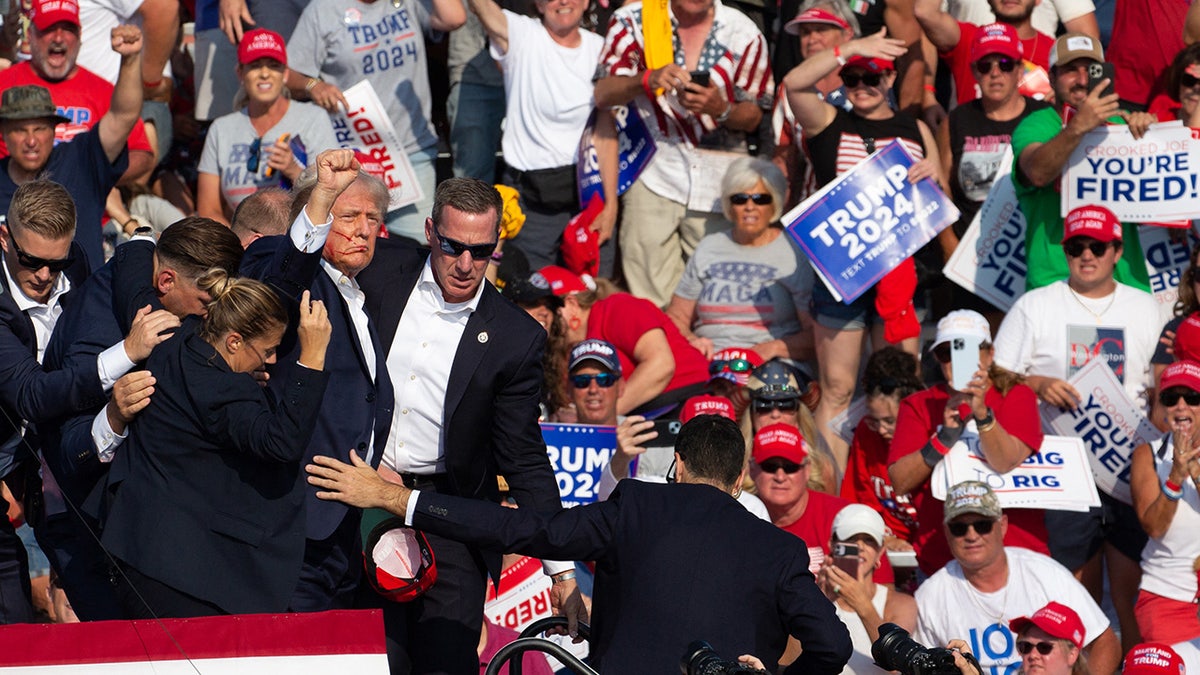
Donald Trump, with blood on his face and surrounded by Secret Service agents, is escorted off the stage in Butler, Pennsylvania, July 13, 2024. (Rebecca Droke/AFP via Getty Images)
«So, to have him ask for that chart, eight minutes in, and to have it come on the side that was opposite, caused him to look in a different direction and lift his head just a little because it was higher, and that just doesn’t happen because it happened,» she said.
«But it was a scary time, and it changed everything for us. The security became front and center, which it hadn’t been before.»
The attack led to an overhaul of the Secret Service in the past year to prevent another attack like the one in Pennsylvania. The Department of Homeland Security issued a report in October 2024, which determined that if the Secret Service didn’t enact reforms, another episode like the one in Pennsylvania was possible.
«The Secret Service does not perform at the elite levels needed to discharge its critical mission,» the report said. «The Secret Service has become bureaucratic, complacent, and static even though risks have multiplied and technology has evolved.»
Since then, the Secret Service has ushered in several key reforms to bolster its security measures and suspended six of its agents due to their response at Butler.
TRUMP ASSASSINATION ATTEMPT AFTERMATH, REACTIONS FROM INNER CIRCLE REVEALED IN NEW BOOK

Donald Trump is surrounded by U.S. Secret Service agents on July 13, 2024, in Butler, Pennsylvania. (Evan Vucci/The Associated Press)
Trump spoke about the attempt on his life days later at the Republican National Convention in Milwaukee, wearing a bandage on his ear and telling audience members he was «not supposed to be here tonight.» In response, the crowd started to chant back, «Yes you are!»
«Many people say it was a providential moment. Probably was,» Trump said at the convention. «When I rose, surrounded by Secret Service, the crowd was confused because they thought I was dead. And there was great, great sorrow. I could see that on their faces.
«As I looked out, they didn’t know I was looking out. They thought it was over. But I could see it. I wanted to do something to let them know I was OK. I raised my right arm, looked at the thousands and thousands of people that were breathlessly waiting and started shouting, ‘Fight, fight, fight.’»
CLICK HERE TO GET THE FOX NEWS APP
Today, a painting depicting Trump’s fist raised with blood smeared across his face stands in the White House’s entrance hall.
White House press secretary Karoline Leavitt told Fox News Digital Friday that «God spared President Trump’s life by a miraculous millimeter.»
«Now one year later, President Trump is standing stronger than ever as he continues to ‘fight, fight, fight’ for the American people,» Leavitt said.
INTERNACIONAL
Crisis en Venezuela: Trump confirmó que habló por teléfono con Maduro
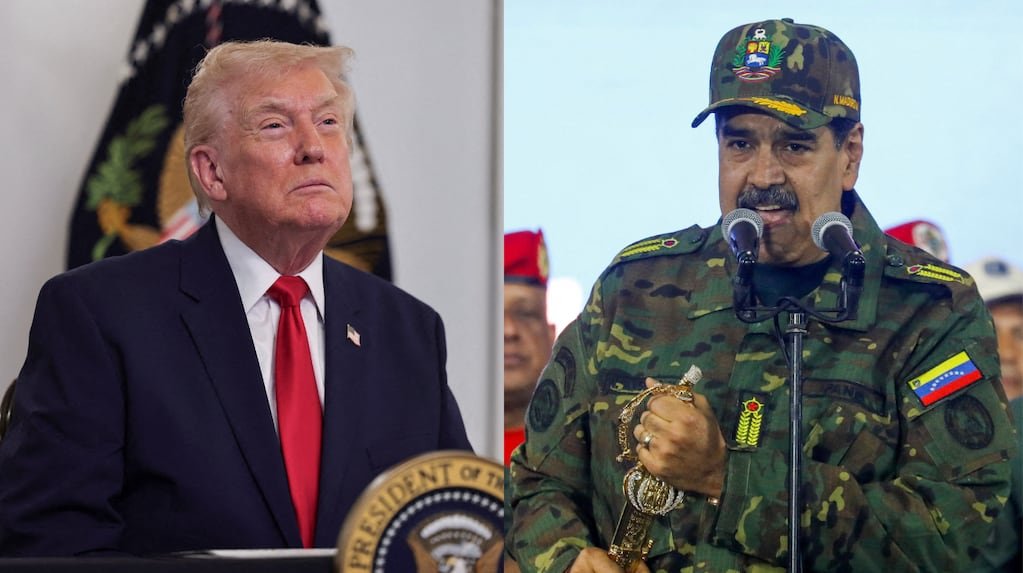
El presidente estadounidense, Donald Trump, confirmó este domingo que tuvo una conversación telefónica con Nicolás Maduro.
“No diría que salió bien ni mal. Fue una llamada telefónica”, dijo el mandatario sobre la conversación que mantuvo con Maduro, de la cual el diario The New York Times fue el primero en informar.
Leé también: Ante la amenaza militar de Trump, los venezolanos se mueven entre el miedo, la incertidumbre y la esperanza
En breves declaraciones, Trump confirmó el diálogo con el gobernante chavista: “No quiero comentar al respecto; la respuesta es sí”.
Trump también dijo que su advertencia sobre el cierre del espacio aéreo venezolano no era una señal de un ataque aéreo inminente. “No supongan nada al respecto”, afirmó.
Poco antes, el senador republicano Markwayne Mullin dijo que el gobierno estadounidense le dio a Maduro la oportunidad de abandonar el país. “Por cierto, le dimos a Maduro la oportunidad de irse”, dijo el legislador a la CNN.
Mullin, integrante del Comité de las Fuerzas Armados del Senado estadounidense, afirmó. “Le dijimos que se podía ir a Rusia o a otro país”. Al ser preguntado si Trump planeaba atacar a Venezuela, el senador de Oklahoma respondió: “No, ha dejado muy claro que no vamos a enviar tropas a Venezuela. Lo que intentamos es proteger nuestras propias costas”.
Venezuela denuncia “violación de su soberanía”
En tanto, el gobierno de Venezuela denunció ante la Organización de Aviación Civil Internacional (OACI) la “violación de su soberanía”, luego de que Trump, advirtiera en un mensaje que se debe considerar como cerrado el espacio aéreo venezolano
Lo anunció este domingo el ministro de Transporte, Ramón Velásquez Araguayán. Un avión de Copa Airlines sobrevuela el aeropuerto internacional de Caracas (Foto: REUTERS/Leonardo Fernandez Viloria)
“El Estado venezolano, en el marco de su diplomacia de paz, ha denunciado por escrito ante la Organización de Aviación Civil Internacional, las graves amenazas contra nuestro espacio aéreo que atentan contra la seguridad en este hemisferio”, indicó el ministro en un comunicado publicado en redes sociales y que fue posteriormente eliminado.
El funcionario indicó que el presidente estadounidense anunció sorpresivamente el “supuesto cierre del espacio aéreo venezolano, sin tener la autoridad requerida para un anuncio de este tenor y sin basamento legal alguno”.
Leé también: España: la oposición de derecha marchó en Madrid y pidió la renuncia del presidente Pedro Sánchez
“Tal acto constituye un caso de interferencia ilícita, tipificado como un grave delito en el anexo 17 del Convenio de Aviación Civil Internacional, al poner en peligro la seguridad operacional de la aviación mediante la difusión de información falsa”, apuntó, citado por EFE.
Velásquez Araguayán ratificó que el ente autorizado para regular el espacio aéreo venezolano es exclusivamente la Autoridad Aeronáutica Nacional (INAC). “Ningún poder extranjero podrá sustituir, en forma alguna, el ejercicio de la jurisdicción venezolana”, insistió.
El Gobierno de Venezuela, prosiguió, rechaza que la Administración de Trump “pretenda amedrentar y presionar a las aerolíneas internacionales que operan en Venezuela y transitan el FIR Maiquetía, causando perjuicios y daños económicos a las empresas aéreas de países como Turquía, España, Portugal, Colombia, Brasil y Panamá, bajo el fraudulento supuesto del control” del espacio aéreo del país suramericano.
Este sábado, Trump advirtió en un mensaje publicado en su red social Truth que las aerolíneas y los pilotos tengan en cuenta que el espacio aéreo de Venezuela “permanecerá cerrado en su totalidad”.
“A todas las aerolíneas, pilotos, narcotraficantes y traficantes de personas: les rogamos que consideren que el espacio aéreo sobre Venezuela y sus alrededores permanecerá cerrado en su totalidad”, afirmó el mensaje del mandatario.
Por el momento, solo Copa, Wingo, Boliviana de Aviación y Satena, así como las compañías locales Avior y Conviasa (estatal) mantienen sus operaciones en el país.
Maduro pidió ayuda a la OPEP
Según una carta de Maduro divulgada este domingo, Venezuela pidió a la Organización de Países Exportadores de Petróleo (OPEP) ayuda para detener la “agresión” de Estados Unidos.
“Espero contar con sus mejores esfuerzos para contribuir a detener esta agresión que se gesta con cada vez más fuerza y amenaza seriamente los equilibrios del mercado energético internacional”, señala la misiva leída por la vicepresidenta Delcy Rodríguez durante un comité ministerial de la OPEP realizado virtualmente.
En la carta, Maduro advierte que Estados Unidos pretende derrocarlo y apoderarse de las reservas petroleras más grandes del mundo. Una acción militar desde el norte “pone en grave peligro la estabilidad de la producción petrolera venezolana y el mercado mundial”, sostiene.
(Con información de AFP y EFE)
Donald Trump, Nicolás Maduro, Venezuela
INTERNACIONAL
Trump gave Maduro ultimatum to flee Venezuela as land operations loom: report

NEWYou can now listen to Fox News articles!
President Donald Trump delivered a stern ultimatum to Nicolás Maduro to leave Venezuela immediately before announcing the country’s airspace should be closed, according to a report.
Per the Miami Herald, Washington’s warning was delivered in a phone call with Caracas and offered guaranteed evacuation for Maduro, his wife Cilia Flores, and their son, but only if the dictator agreed to resign on the spot.
The conversation stalled, U.S. officials said, and within hours Washington escalated dramatically.
The ensuing impasse, a source told the outlet, was over Maduro asking for «global amnesty for any crimes he and his group had committed, and that was rejected.»
MADURO BRANDISHES SWORD AT RALLY AS HE RAILS AGAINST ‘IMPERIALIST AGGRESSION’ AMID RISING TENSIONS WITH US
Venezuelan leader Nicolás Maduro brandishes a sword during an event at the military academy in Caracas, Venezuela, Tuesday, Nov. 25, 2025. (Ariana Cubillos/AP Photo)
«Second, they asked to retain control of the armed forces — similar to what happened in Nicaragua in ’91 with Violeta Chamorro. In return, they would allow free elections.»
The final issue was timing, according to the outlet, as Washington demanded that Maduro resign immediately – but Caracas refused.
Trump went on to announce Saturday that Venezuelan airspace would be considered «closed in its entirety.»
The Herald also reported that the Maduro government tried to schedule another call to Washington but received no response.
According to a defense expert familiar with the country’s military and state-linked cartel ties, Maduro and key players in his regime could now face their most serious threat yet.
«I think the operations will start imminently,» former Venezuelan diplomat Vanessa Neumann told Fox News Digital.
«The clearing of the airspace is an indication and a very clear public warning that missiles might be coming to take out command and control infrastructure or retaliatory infrastructure,» Neumann said. «This will not be like breaking a jar into a thousand pieces, this is where you can lift the concentration of power, and it’s easier to manage.»
«The targets have been identified through covert operations over the last several years by people on the ground,» she continued. «So they’re well-mapped. This is a capture-or-kill scenario, but there’s a limit to how many people you can remove quickly.»
On Sunday, Trump told reporters aboard Air Force One not to «read anything into» his declaring Venezuela’s airspace closed when asked if a strike was imminent.
«Maduro also doesn’t have that many options, and his military is very weak,» she warned. «You can’t go after 30 people simultaneously, who are spread all around, but certainly high on the list would be Maduro himself.»
TRUMP PUSHES PEACE IN EUROPE, PRESSURE IN THE AMERICAS — INSIDE THE TWO-FRONT GAMBLE
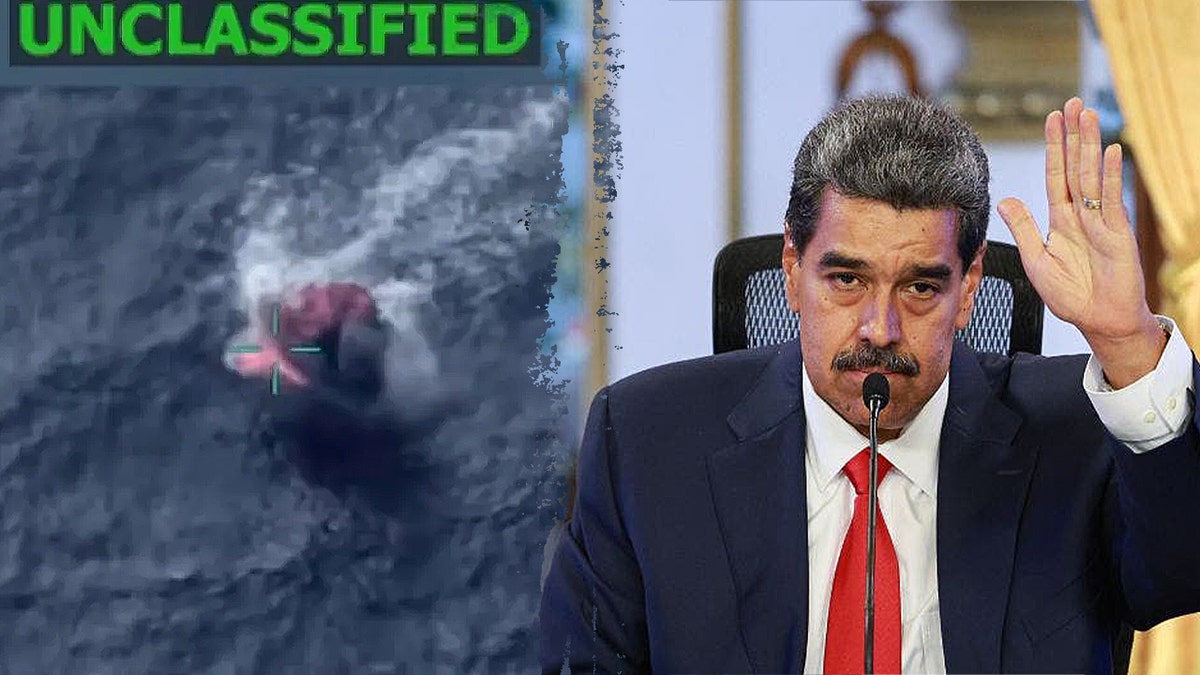
U.S. strikes on drug boats near Venezuelan waters may be targeted at taking out Venezuelan leader Nicolás Maduro. (@realDonald Trump/Truth Social; Jesus Vargas/Getty Images)
Venezuela’s armed forces, once among Latin America’s strongest, have been weakened by years of corruption, sanctions, defections, and lack of maintenance. Much of its equipment, Neumann says, has never even been serviced.
«Their material is extremely old, decayed, and has not been serviced,» Neumann explained.
«They’ve got junk from the Russians. The stuff they originally had from the Americans is decades old and has not been serviced.
«So, they have neither the personnel, foreign support, nor the material,» she said.
Ahead of shuttering the airspace, the U.S. also officially designated the cartel allegedly linked with Venezuela’s government, the Cartel de los Soles, as a foreign terrorist organization.
«This cartel turned Venezuela’s main oil company into a narcotics trafficking money laundering operation, using the company’s access to international finance, until it was sanctioned,» Neumann, who has worked with governments on countering transnational organized crime linked to the group, explained.
«They were using Venezuelan military jets to bring in cocaine from Colombia, process it in Venezuela, and then move it into Central America and then into Europe.
IRAN BACKS MADURO TO KEEP LATIN AMERICA FOOTHOLD AS TRUMP INCREASES PRESSURE ON VENEZUELA

Venezuela’s President Nicolás Maduro was reportedly told he must leave Venezuela to save himself and his family. (Ariana Cubillos/AP Photo)
«Jet pilots were making a lot of money off that, and they’ve tortured people. They target people, anybody who tell on them, they’re disappeared,» Neumann said. «They’re now one of the prime drug trafficking networks into the United States and Europe, and use their military positions, including their military-to-military relations, to grow and accelerate those movements.»
In fact, in September, the European Parliament also voted in favor of the EU designating Cartel de los Soles as a terrorist organization.
«The Cartel de Los Soles is also a key collaborator and financier of Hezbollah and some of the drug money has been used to fund terrorist attacks that have killed American citizens, even in the Middle East,» added Neumann, CEO of Asymmetrica Group, which specializes in defense cooperation.
The U.S. has also ramped up a military and intelligence campaign targeting drug-trafficking networks linked to Venezuela, including strikes on suspected narcotics boats.
TRUMP’S STRIKE ON CARTEL VESSEL OFF VENEZUELA SENDS WARNING TO MADURO: ‘NO SANCTUARY’
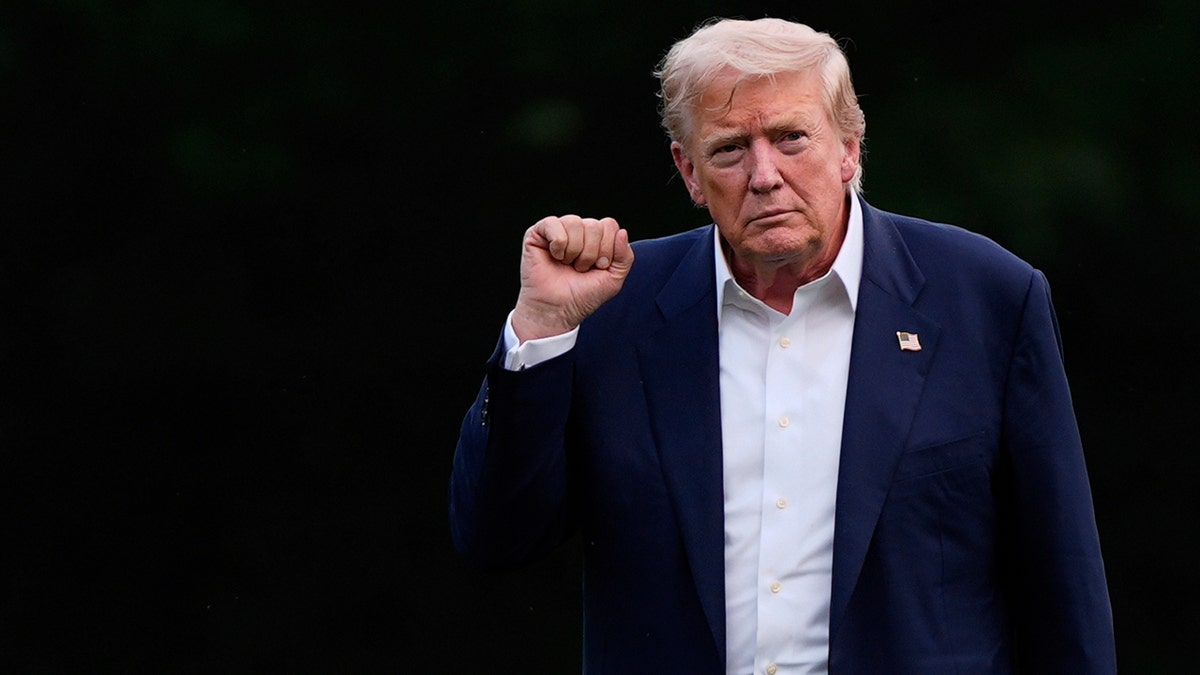
President Donald Trump walks from Marine One after arriving on the South Lawn of the White House, Tuesday, July 29, 2025, in Washington. (Julia Demaree Nikhinson/AP)
«The decision is President Trump’s because when he says, ‘Go’, we go. And nobody knows when he’ll say that,» Neumann said. «He has mobilized so many assets down there now. But what President Trump is doing now is long overdue.»
«The timing is right now,» she added. «Because even Maduro’s biggest backers, Russia and Iran, are both on the back foot, and China will not go that far in backing Maduro as it has bigger and broader interests throughout the region.»
She also noted that «Maduro is also weakened because his partners are weakened and have their own issues to deal with,» and that «we also now have a concentration of power and deep repression within the country that’s quite unified, which means it’s easy to flip.»
WASHINGTON’S SHADOW WAR: HOW STRIKES ON CARTELS THREATEN TO COLLAPSE MADURO’S REGIME

Government loyalists hold a poster of the late former President Hugo Chavez outside the presidential palace during a rally in support of President Nicolás Maduro’s reelection one month after the presidential vote, in Caracas, Venezuela, Wednesday, Aug. 28, 2024. (Ariana Cubillos/AP Photo)
Neumann identified others in the regime who may be targeted, including Vice President Delcy Rodríguez, Diosdado Cabello, Minister of Interior, Justice and Peace and Alexander Granko Arteaga, head of Venezuela’s counter-intelligence agency, the DGCIM.
«One of the reasons Granko is an important figure is that he’s one of the reasons why they haven’t capitulated and why there has not been a military uprising,» Neumann explained.
«It’s because of the brutality of the counter-intelligence that they do to their own military, and hundreds of soldiers are tortured. That said, the Venezuelan people have made it clear that they wanted Maduro out and fought democratically but lost,» she added.
CLICK HERE TO DOWNLOAD THE FOX NEWS APP
«They voted in elections, protested peacefully, lobbied for sanctions, and lobbied for international support,» Neumann said.
venezuelan political crisis,foreign policy,donald trump
INTERNACIONAL
Ukraine peace talks productive as ex-government official says country rethinking ‘uncompromising’ stance
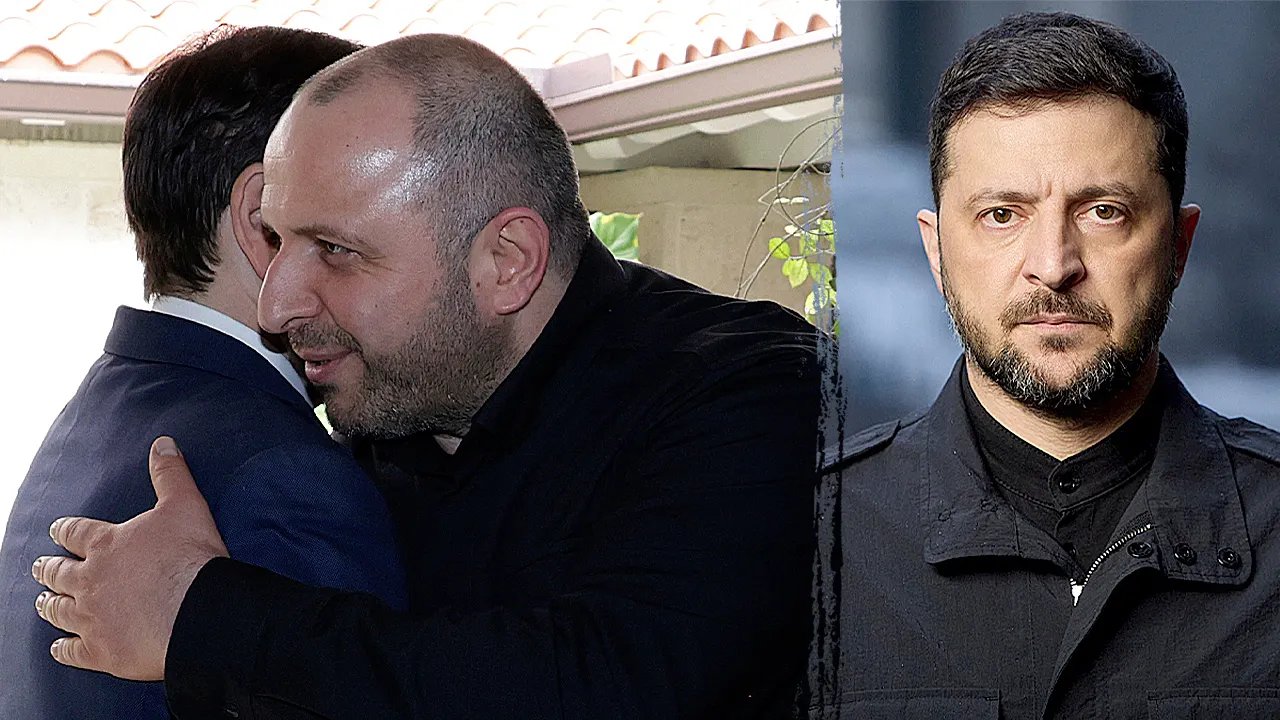
NEWYou can now listen to Fox News articles!
Official peace talks between the U.S. and Ukraine on ending the Ukraine war moved to a productive phase Sunday – but only after President Zelenskyy sent a new-look team to Florida, according to a former Ukrainian government official.
With Rustem Umerov now leading Zelenskyy’s team and longtime adviser and chief of staff Andriy Yermak out, the source claimed the move signaled Kyiv was reassessing its «uncompromising» stance.
The official, who spoke to Fox News Digital on condition of anonymity, said the personnel choice represented a move away from the approach that has shaped Ukraine’s diplomatic strategy for years.
«Yermak had been teaching Zelenskyy to be a ‘Father of the Nation’ and until now, the Ukrainian side has been pushing for an unachievable and uncompromising position,» the former official said.
MOMENTUM BUILDS IN UKRAINE PEACE PUSH, BUT EXPERTS FEAR PUTIN WON’T BUDGE
Ukrainian officials, left to right; Andrii Hnatov, Chief of the General Staff, Vadym Skibitskyi, Deputy Chief to the Head of the Defense Intelligence and Rustem Umerov, Secretary of the National Security, during a meeting with U.S. officials Sunday, Nov. 30, 2025, in Hallandale Beach, Florida. (Terry Renna/AP Photo)
«Umerov is not a very impressively strong individual in politics, but he wants to achieve results and is known to be aligned with compromise.»
Ukraine’s new delegation also included Andrii Hnatov, head of the armed forces; Andrii Sybiha, the foreign minister; and Umerov, who is head of the country’s security council.
After the meeting, Umerov offered a brief assessment to reporters, saying: «We are grateful to American people, American leadership and a great team with, state secretary, Steve, with both Jared Kushner for their tremendous work with us,» he said.
«Our objective is a prosperous, strong Ukraine. We will [be] discussing [sic] the future of Ukraine. We discussed all the important matters that are important for Ukraine, for Ukrainian people. And the U.S was super supportive.»
«We already had a successful meeting in Geneva, and today we can continue this success. So at the moment, this meeting was productive and successful in the later stages.»
MOMENTUM BUILDS IN UKRAINE PEACE PUSH, BUT EXPERTS FEAR PUTIN WON’T BUDGE
The new team traveled to Florida for discussions aimed at refining President Trump’s proposed framework and his push to end Russia’s war against Ukraine.
Sunday’s negotiations also took place after a leak published by Bloomberg News, revealed a transcript of an Oct. 14 call where special envoy Steve Witkoff allegedly offered advice to Russian officials on how to sell a peace plan to Trump.
«The Ukrainian side had in some way undermined peace negotiations and Donald Trump’s efforts, not mentioning that it prolongs the war,» the former official said.
UKRAINIAN OFFICIAL YERMAK RESIGNS AS CORRUPTION PROBE ENCIRCLES ZELENSKYY

Head of the Office of the President of Ukraine Andriy Yermak, left, and U.S. Secretary of State Marco Rubio talk to the press as their consultations continue at the U.S. Mission to International Organizations in Geneva, Switzerland, Sunday, Nov. 23, 2025. (Martial Trezzini/Keystone via AP)
The same former official said the shift in Kyiv’s delegation followed the dramatic resignation of Yermak, after anti-corruption investigators raided his home on Friday.
«Yermak was deeply distrusted by many actors, including Western actors including the U.S. administration and including Biden’s administration,» the source added.
Despite his exit, the official warned that Yermak’s influence may still be shaping the Ukrainian team.
«Mr. Yermak is still there and, in fact, all the delegation that came to Florida includes Mr. Yermak’s people, his loyal people, very close personally to him – people who [have] been serving him faithfully for years.»
«Yermak has not disappeared and might be on the telephone or online and ruling the agenda behind the scenes,» they added.
RUBIO, WITKOFF MEET WITH UKRAINIAN OFFICIALS IN PUSH TO FINALIZE DEAL AFTER ZELENSKYY’S TOP NEGOTIATOR RESIGNS

Secretary of the National Security and Defense Council of Ukraine Rustem Umerov and Secretary of State Marco Rubio embrace after a meeting on Sunday, Nov. 30, 2025, in Hallandale Beach, Fla. (Terry Renna/AP Photo)
They said Yermak’s long-standing governing style still influences Kyiv’s political posture:
«In Ukraine, as in many post-Soviet countries, there is still the so-called ‘telephone rule’, when a powerful person can influence the outcome of any formal decision-making despite lacking formal powers and in contradiction with the law.»
«Yermak has been doing this for the last six and a half years,» the source added.
Secretary of State Marco Rubio, Witkoff, and senior advisor Jared Kushner led the American side in Sunday’s session.
Rubio told reporters after the meeting: «We had another very productive session. Building off Geneva, building off the events of this week,» he said.
ZELENSKYY WARNS UKRAINE FACES ‘DIFFICULT CHOICE’ AS US PEACE PLAN HITS MAJOR HURDLE

White House Special Envoy Steve Witkoff, U.S. Secretary of State Marco Rubio, and Jared Kushner listen as Secretary of the National Security and Defense Council of Ukraine Rustem Umerov speaks while leading Ukrainian delegation during a meeting in Hallandale Beach, Florida, on Nov. 30, 2025. (Chandan Khanna/AFP via Getty Images)
«As I told you earlier this morning, our goal here is to end the war,» he continued. «But it’s more than just to end the war. We don’t just want to end the war. We also want to help Ukraine be safe forever. So never again will they face another invasion. And equally importantly, we want them to enter an age of true prosperity.»
Trump told reporters aboard Air Force One on Sunday that he had spoken to Rubio and Witkoff and that they were «doing well.»
«Ukraine’s got some difficult little problems,» Trump said. «They have some difficult problems. But I think Russia would like to see it end and I think Ukraine… I know Ukraine would like to see it end.»
He also said he thinks there is «a good chance we can make a deal.»
In a post shared on X, Zelenskyy highlighted Umerov’s work in Florida as the head of the Ukrainian delegation.
«Today, following the work of the teams in the United States, head of the Ukrainian delegation Rustem Umerov reported on the main parameters of the dialogue, its emphases, and some preliminary results,» he said.
«It is important that the talks have a constructive dynamic and that all issues were discussed openly and with a clear focus on ensuring Ukraine’s sovereignty and national interests. I am grateful to the United States, to President Trump’s team, and to the President personally for the time that is being invested so intensively in defining the steps to end the war. We will continue working. I look forward to receiving a full report from our team during a personal meeting.»
CLICK HERE TO DOWNLOAD THE FOX NEWS APP
Sunday’s talks came just hours after another deadly Russian strike on Kyiv killed at least one person and wounded 19, including four children, Euronews reported.
Since Russia’s full-scale invasion in 2022, the war has left huge areas of Ukraine devastated and roughly 20% of its territory under occupation.
ukraine,volodymyr zelenskyy,marco rubio,donald trump,wars,russia

 INTERNACIONAL3 días ago
INTERNACIONAL3 días agoTrump promete “suspender permanentemente la migración de todos los países del tercer mundo”

 CHIMENTOS2 días ago
CHIMENTOS2 días agoWanda Nara involucrada en el escándalo de su abogado, Payarola, contó toda su verdad: “Yo fui…”

 CHIMENTOS2 días ago
CHIMENTOS2 días ago¡Urgente! Internaron a Rocío Marengo por un problema en su embarazo de 8 meses: «Vieron cosas que preocuparon»















